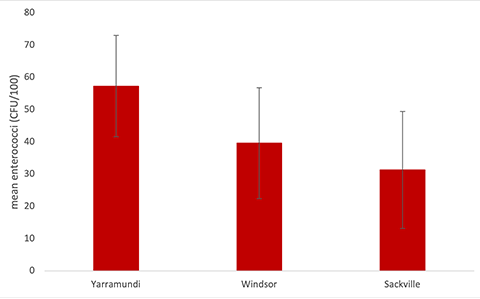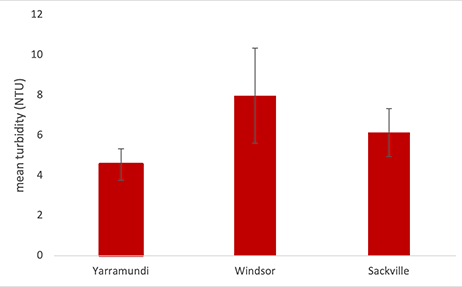Swimability
With summer increasing temperatures in Western Sydney, locals take refuge at local swimming spots close to home, like the Hawkesbury-Nepean River. Locals have enjoyed swimming here for years but there’s never been answers about whether it’s a good idea or not.
We looked at swimability indicators bacteria and visibility at our three sites – Yarramundi, Windsor, and Sackville. Swimability is the use of areas that are safe and suitable for human swimming.
Bacteria
Enterococci levels change depending on local sources which can vary widely throughout the river. Swimming during periods of high levels of bacteria in the water may make humans quite sick. Above 40 cfu/100 is it not recommended for safe swimming.
Out of the 12 weeks our sampling took place, 4 weeks had levels outside of the recommended guideline values.*
*Australian Govt. Guidelines for managing risks in recreational water, NHMRC, 2008).

The graph above shows the mean enterococci levels at our three sampling sites in the Hawkesbury-Nepean River. As you can see there is a difference in the mean between sites, but the large error bars show that there is a variation at each site week to week. As discussed below there are a number of reasons why there is a variation in the readings, however as more data is collected we expect these error bars to get smaller.
A few reasons why it could be outside of the recommended guideline values:
- Recent rainfall in the catchment area
- Leaking septic tanks on properties along the River
- Livestock grazing along the riparian zone
Visibility
Turbidity is important for many reasons. High levels hide bacteria, and impact aquatic plant growth as it reduces light penetration. Low turbidity in our river is needed for safe swimming and is what we should be aiming for.
During our 12 weeks of sampling, turbidity ranged from 0 – 27 NTU across all three sites, which is within guidelines.*

The graph above shows the mean turbidity levels at our three sampling sites in the Hawkesbury-Nepean River. All of these levels are within the ANZECC (2000) guidelines.
* The guideline value for low lying rivers is 50 NTU (Australian and New Zealand Guidelines for Fresh and Marine Quality (ANZECC), 2000).
A few reasons why River’s can experience high turbidity:
- Stormwater runoff from urban areas around our River
- Recent flooding events along the Hawkesbury-Nepean River
- Removal of riparian vegetation along the River
A Western Sydney University undergraduate Science student conducted standard in-situ and lab-based water sampling from three recreational sites along the Hawkesbury-Nepean River – at Yarramundi, Windsor, and Sackville. Bacteria, nitrates, and phosphates were analysed on campus and the data was verified by Western’s aquatic specialist.
Download our full data set summary for our three sites (PDF, 55.1 KB) (opens in a new window). To learn more about our data collection or to understand our data summary, contact us.
Mobile options:

